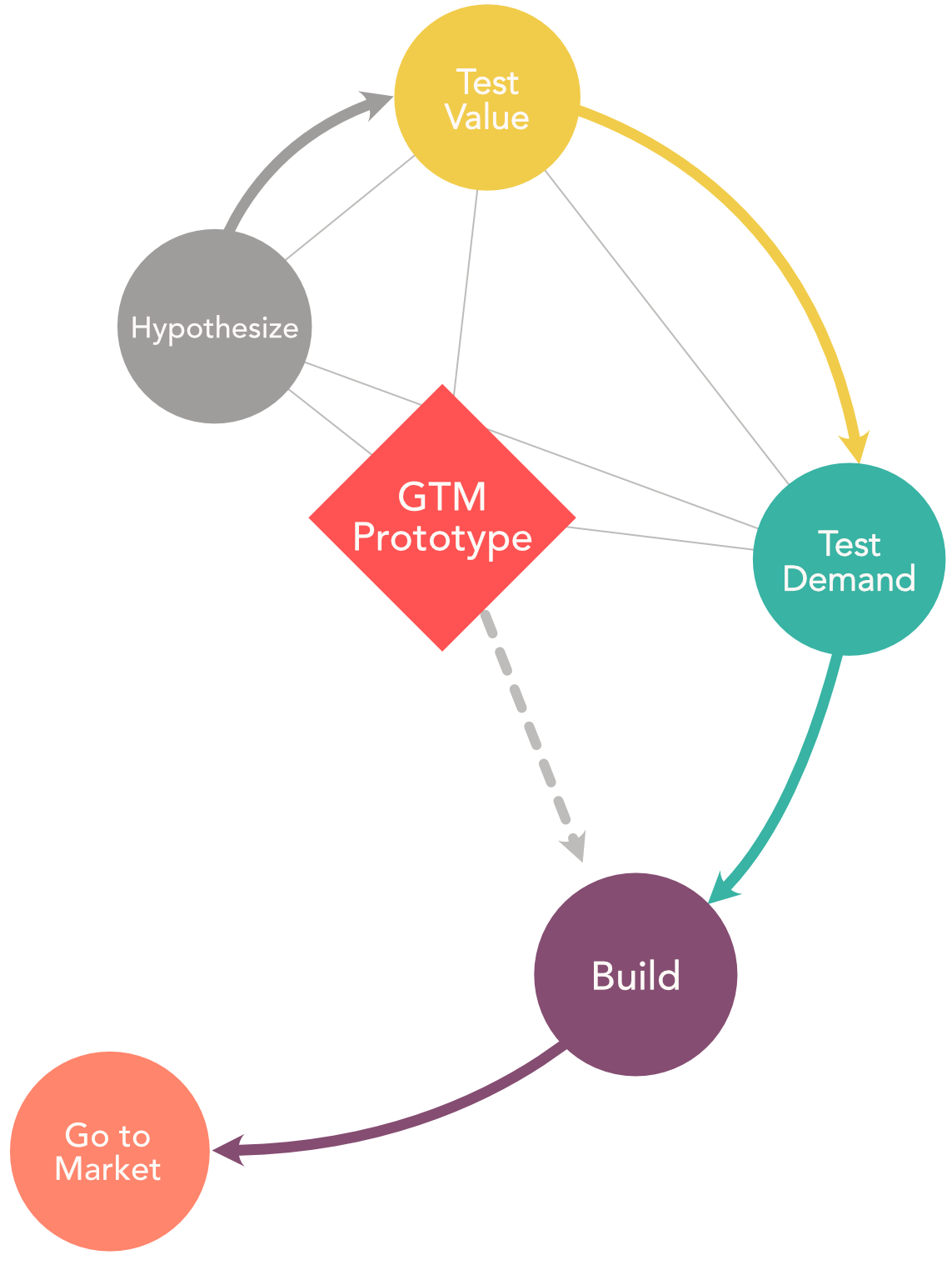GTM Prototyping
GTM Prototyping is a process of iterative experimentation and prediction that aligns your teams and validates your next product offering.
New Product Development
Ensure you have validated all the parts of an offering before you invest in building.
Escape Analysis Paralysis
Your team has lots of ideas, but struggles to make decisions.
Grow an Existing Product
Add a new use case, expand to a new customer segment, “debug” a current offering.
A Five Stage Process
GTM Prototype is a five stage process that combines knowledge management with Value Testing and Demand Testing.
1. Create Hypothesis
Begin by putting a stake in the sand. Define your ICP, what key affordances your product will have, pricing, positioning, and demand generation strategy. As you conduct experiments and learn more, you update your GTM Prototype.
2. Test Value
Value Testing is the first type of experiment you run. Use methods such as JTBD Design to predict if and why ICPs will, or won’t, find your innovation valuable.
3. Test Demand
Demand Testing comes after value testing. Use methods such as Simulated Selection to package your innovation(s) into an offering to test if consumers will select it over comparable products. This is when you test product, positioning, and pricing.
4. Build
After iteratively removing risks, it’s time to start Building. Using the GTM Prototype as a guide, your teams do what they do best to fill in the blanks and details. Product builds, marketing designs campaigns, and sales prepares their outbound and inbound strategies.
5. Go to Market
When your team is ready, you Go to Market with confidence. If you need to adapt your offering, you can do another GTM Prototyping iteration.
The GTM Prototype
The GTM Prototype is a repository used for planning, knowledge management, and decision making.
It’s a collection of worksheets, storyboards, and a website or deck that are used to know what data to gather, plan experiments, manage decisions, and keep everyone aligned.
Artifacts
JTBD Design
Value testing is done using a method called Job to be Done Design (JTBD Design). The aim is to figure out what Jobs the product should do for various ICPs by introducing consumers to new affordances, and showing how those affordances would transform how they will live or work.
As you show ICPs these Jobs, you capture how they respond along dimensions such as relevance, trust, affordance affinity and usability. Acceptance is green, rejection is red.
JTBD Design uses factorial design to quickly explore different scenarios and variations of your innovation. Factorial design is a methodology where experiments use slight variations of stimuli to predict which combinations will or won’t work.
Method
Testing Demand
After you confirm ICPs will find your innovation(s) valuable, it’s time to do Demand Testing.
GTM Prototyping tests demand through Simulated Selection. This method entails packaging your innovations into an offering, building a website for it (sometimes a sales deck), and then putting that website or deck in front of ICPs alongside competing products.
The aim is to simulate the experience consumers go through as they shop for a new product. You track what information they gather, how they interpret it, and how that use it make a decision. The aim is to produce an offering that consumers end up choosing over the alternatives.
Simulated Selection uses the Hiring Process from Jobs theory as well as Factorial Experimentation to predict which variations of your product offering will generate a willingness to hire from ICPs.
Method
Factorial Experimentation
GTM Prototyping keeps teams moving fast because it uses factorial experimentation. This methodology entails experiments whose design consists of two or more factors, each with discrete possible values or "levels", and whose experimental units take on all possible combinations of these levels across all such factors.
Such an experiment allows the investigator to study the effect of each factor on the response variable, as well as the effects of interactions between factors on the response variable.
Methodology
Get our Playbook
Our 42 page Playbook will help you get started with Go to Market Prototyping
Jobs to be Done 2.0 is around the corner
Sign up to be notified about new videos, books, and training products.









